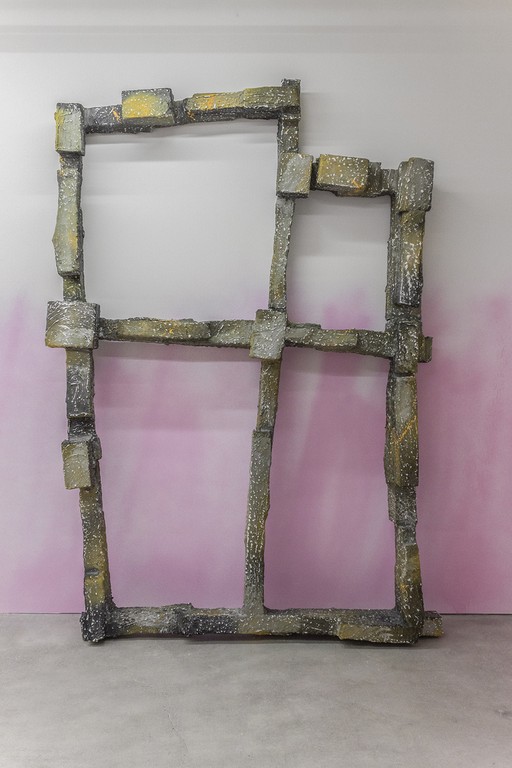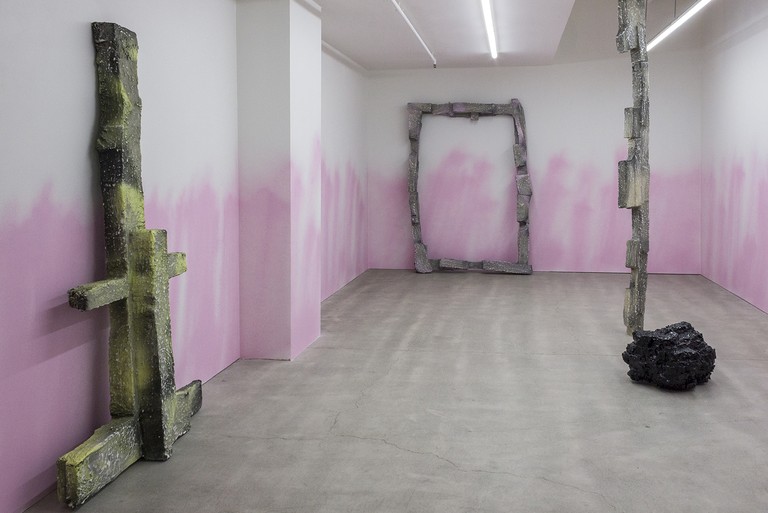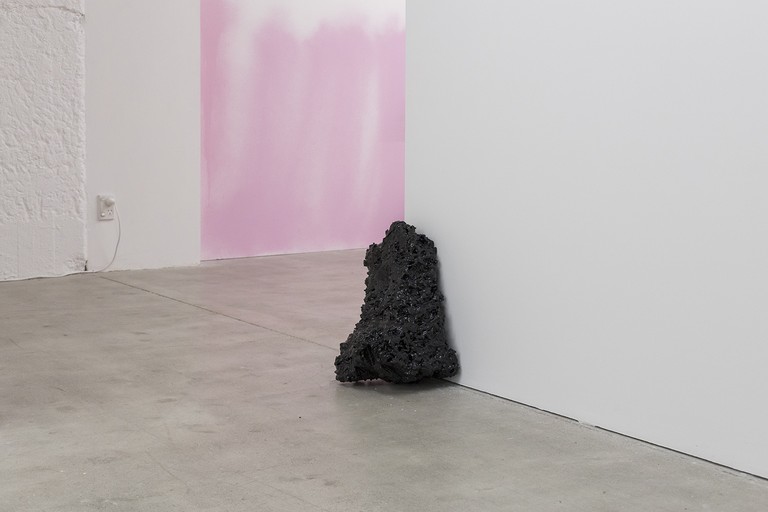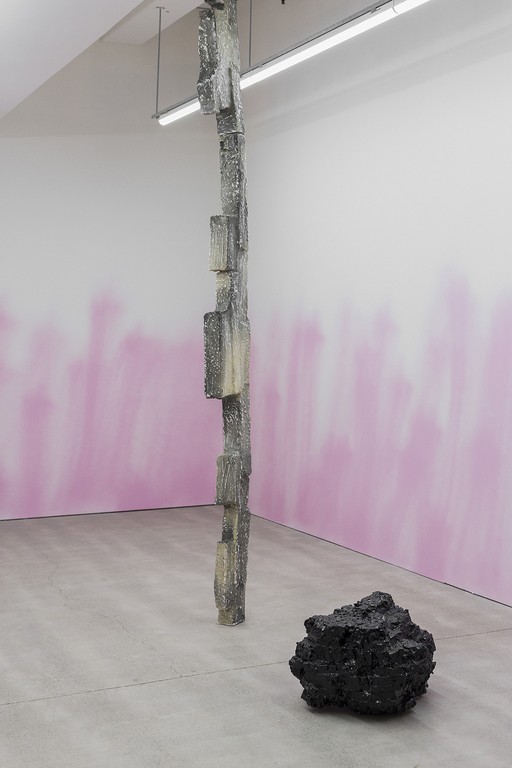Exhibition Essays
Dreaming in and out of language
January 2020
Dreaming in and out of language
Rose Lu
Using household objects as the starting point, Emerita Baik shows us these items stripped down to their bones. Tokens of significance, like prayer cards and photographs, become rickety echoes of their former selves when transformed into stacked sculptures. They are constructed from plaster and foam, adhered with a deliberate imbalance, growing to reach teetering heights. Baik’s sculptures are the colours of construction: concrete grey, asphalt black, the yellow neon of imminent work. The colder tones make the sculptures feel distant, alienated. These sculptures ask us to question what we need to create a life. Many of us have moved across oceans, taking with us items that will recreate the former home in the new home. Is that which cannot be reproduced irrevocably lost in this process? Can a replica conjure up the same sensations and memories? What are we seeking in the rituals of recreation?
The home should be a place of comfort and safety. It is where we are our most vulnerable, where we are able to create our own rituals. Migrant homes in particular exist in a liminal space, incorporating elements of old homes in the newer homes. They are constantly in a state of flux, trying to find a point of rest while their past and present homes move past them. Perhaps all that we can truly cling to is the skeletons of our household objects, leaving the rest to be filled in by memory, by passed down stories, by the gaps that exist between a language and its translation.

Emerita Baik, 3:16, 2020. Image courtesy of Cheska Brown.
For years, it felt like my parents and I talked past each other. On observing the same object or situation, we would draw different conclusions. It was like our instincts were wired differently. At Mandarin classes in Sichuan University, I experienced some of the disorientation that my parents must have had with language. Particular sound combinations or characters would conjure up specific feelings in me, and I would feel that the meaning would match the feeling of joy or disgust I associated with it. For example, the word 雅, yǎ, pronounced with the hard “y” sound. In my mind, it sounded tough, uncouth. I could hear Souljah Boy shouting it. I was certain that its meaning would be similarly unrefined, but its definition turned out to be “elegant.” The sound of the third tone “ǎ” was nasal and drawling, and I couldn’t believe that it meant elegant. I wanted to share this dissonance, but there was no one around who would understand my reference points.

Emerita Baik, 꿈 / ɯnʞʞ, 2020, installation view. Image courtesy of Cheska Brown.
There must have been an age at which I stopped dreaming in Mandarin. I rarely remember dreams, maybe one every three or four months. It must exist, but I can’t go back to a time where I dreamt in anything other than English. Before I went to China for language school, there were a number of promises that I had collected from friends who had spent time living within other languages. “Language is strongly linked to memory, you might remember new things about China when your Mandarin improves,” said one. “After two months in France I started dreaming in French,” said another. Neither of these promises came true for me. My dreams have always been especially slippery, and I can’t recall even a single dream I had in my time in China.
*
My dad once showed me an article about the Mona Lisa in a Chinese periodical. “Did you know that the painting is smaller than you think? She’s smaller than her fame.” I peered at the postage stamp sized print of the painting. My mum also came over to look. “I’ve never seen this painting before. Why is it famous?” she asked. “You’ve never heard of the Mona Lisa?” I replied incredulously. My mum shrugged. She’d never seen or heard of it before. I considered her question. Actually, I didn’t know why it was famous. But it has always decorated the backdrop of my life, her image and fame a steady reference point for popular media. “It’s her famous smile!” my dad exclaimed, brandishing the magazine under her nose. She took the magazine and squinted at the pixelated reproduction of her beguiling smile. “What’s so special about it?” she asked. She didn’t get it. People have died for this smile. Looking at it again, I didn’t get it either.

Emerita Baik, Nutella and egg, 2020. Image courtesy of Cheska Brown.
New Mandarin words felt like fragments of poetry, there was a charm to their expression. 方便面 | convenient noodles, 牛油果 | cow’s oil fruit, 雪中送炭 | to deliver coal in a snowstorm. The untrained eye has a freshness, a newness, one that can see possibilities that have been discounted by experience. How boring it would be if we all saw the same outcome. To live in between states is to live unguarded, to open yourself to new ways of being. Baik’s sculptures show the necessary adaptation of rituals. As we interpret the objects of our family home, they become different again, their insides are brought out and rearranged into novel forms. Like offering kiwifruit in front of a statue of the Iron God of Mercy. Like buying a set of horse print placemats from Farmers. Like living in a house with a dishwasher but still washing each bowl by hand.
*
I dream that the world is ending. A meteorite has struck the equator, and waves of molten lava have begun to encase the land sea. I am in Australia with my partner, at a popular tourist lookout. “We have to run to that high point,” I say, pointing at the lookout opposite us. The lava is thinning as it travels out from the epicenter, and there’s a chance we’ll be spared if we get high enough. We slide down the slope, then begin the gasping climb up the next hill. The hopeless line the path, their limbs slackening to the ground. “It won’t be high enough,” one says, peering at us through matte irises. I grit my teeth. We have to try. I wake up and text my mum. “Have you ever dreamed in English?” I ask her in Mandarin. “从来没有,” she replies emphatically. She never has.
*
To be understood is a privilege. To meet with another at a place of understanding requires careful insight and empathy. For language to be an additional barrier, rather than a conduit for exchange, makes this exercise even more challenging. In Baik’s reimagining of household objects, I see her asking many questions that I have posed myself in the past: what does this object mean to me; how can I make it truly mine. The inverted dreamscape she has created of irregular obsidian structures, juxtaposed against fuchsia streaked walls, brings to life the spaces that spark between disparate states of being. These are the homes that we alone can know.

Emerita Baik, 37:5–6 and Cheese and apple, 2020. Image courtesy of Cheska Brown.
